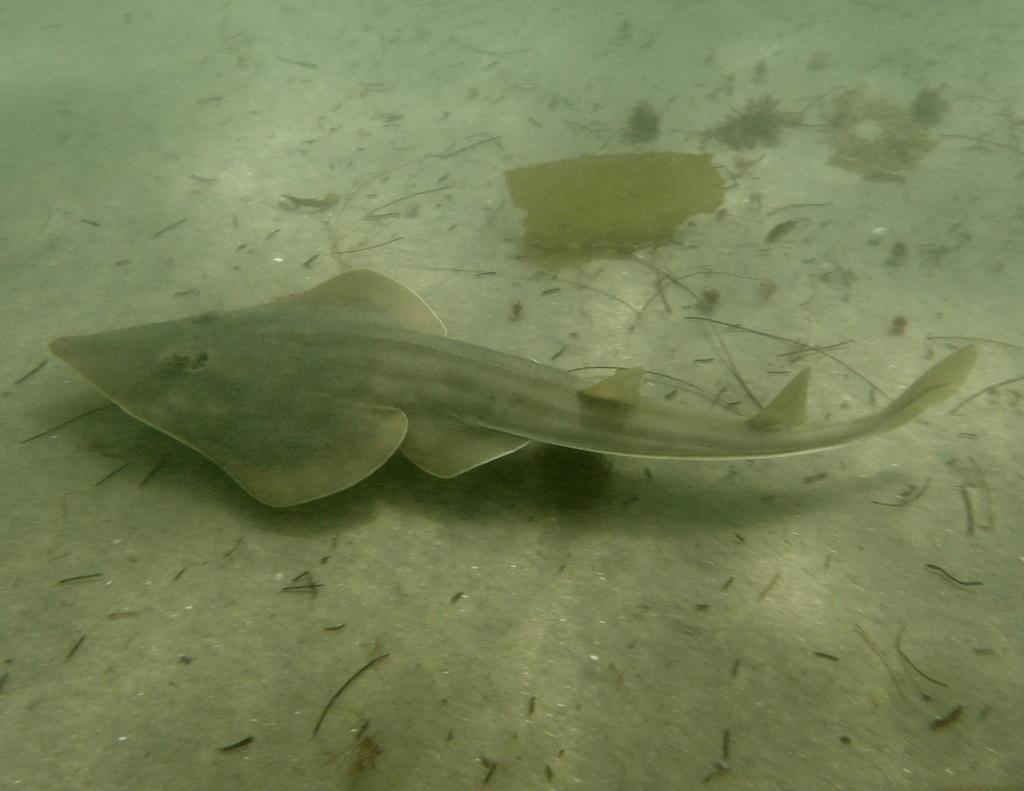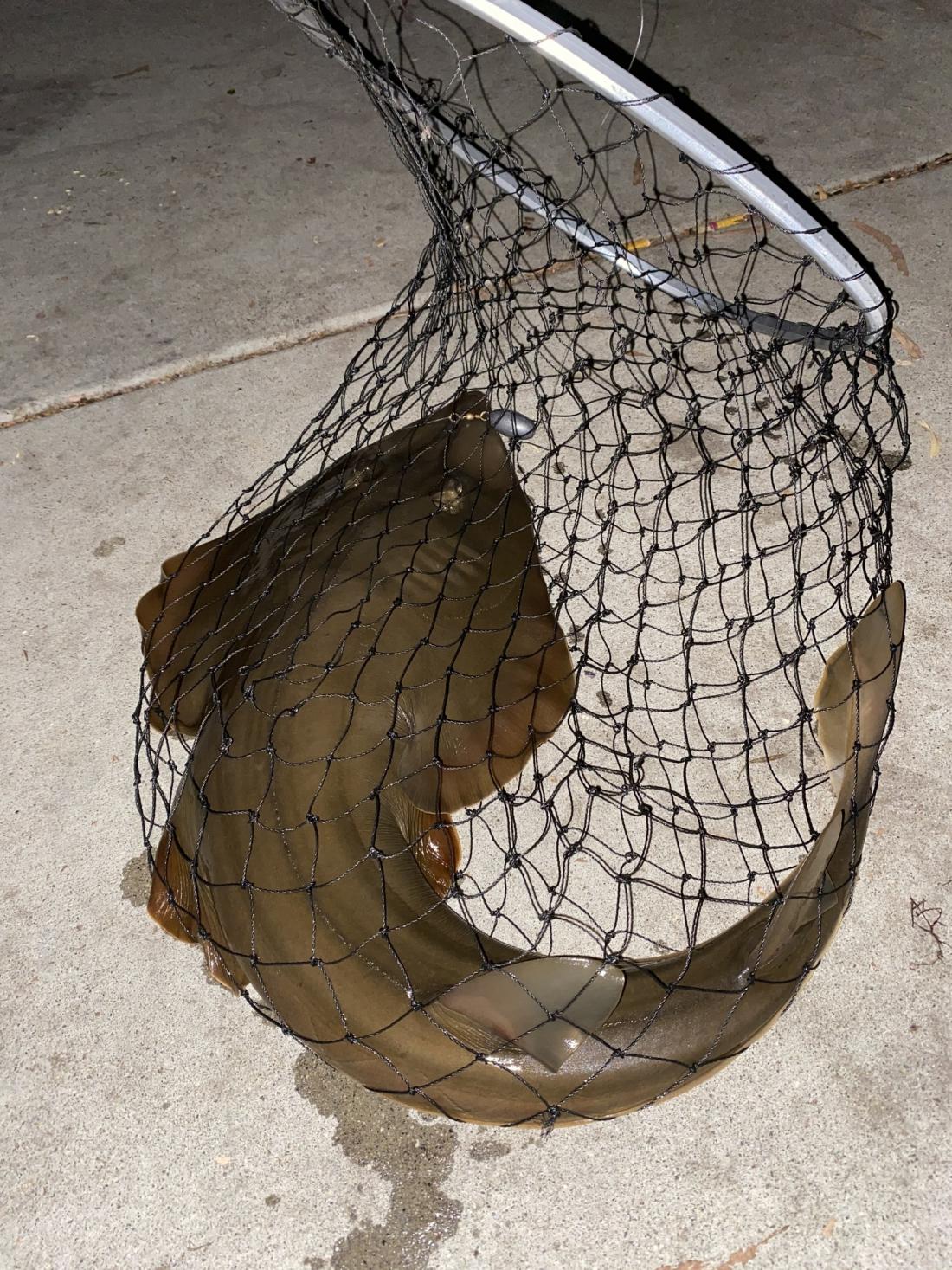Shovelnose Guitarfish
Rhinobatos productus
The Science
THE SCIENCE
A sit and wait predator during the day, the guitarfish hunts by staying hidden in the sand until it sees prey. At night, the guitarfish actively hunts prey near the seafloor. [11]

Taxonomic description
- As ray that grows up to 1.7 m long, it is a brownish grey color that blends in with the sand, and has a flat body. [11]
- Uses its long tail to move through the water, so it resembles a shark more than it does a ray. [11]
Distribution
- Ranges from Northern California to the Gulf of California. [11]
Life history
- Lives about 11-16 years. [4]
- Mature males have large claspers proportional to their bodies and have spines. Females are mature when their shell gland and uteri are developed. [6]
- Males mature at 8 years old and females mature at 7 years old. [4]
- Mating occurs every summer between monogamous partners. Females carry eggs for 9-12 months before giving birth to a litter of 6-28 pups. [4]
- Females give birth in shallow waters from June to October. [4]
Habitat
- Lives on the sandy seafloor of bays and estuaries up to 12 m deep. [11]
- Preys on crabs, worms, small fish, and clams. [11]
- Is preyed on by large birds and mammals. [4]
- Its generally shallow habitat makes it easy catch for fishermen, though its population is not in danger because there is not a high demand for shovelnose meat. [6]
The Fishery
THE FISHERY
Once a trash fish discarded by fishermen, there is now demand for these fish. [11]

Seasonal availability
- Available year-round, though from 2013-2015 landings (in lbs) in California were lowest (close to zero) from July through September, and highest in either January (2013, 2015) or November (2014). [7]
Regulatory and managing authority
- The shovelnose guitarfish fishery is managed federally by the NOAA fisheries and, as established by the Magnuson-Stevens Act, the Pacific Fishery Management Council (PFMC) through the Pacific Coast Groundfish Fishery Management Plan (FMP). [12]
- As established by the Marine Life Management Act, the California Fish and Game Commission (CFGC) regulates the fishery in state waters, and the California Department of Fish and Wildlife (CDFW) manages this fishery. [2]
- The California Groundfish Collective combines input from the industry and government entities to inform regulatory and management measures for this fishery. [13]
Gear type
- Similar groundfish species are caught with traps, hooks, and lines; even though this species is not specifically listed it is likely caught with similar gear. [5]
Status of the fishery
- May be vulnerable to overfishing because it is long-lived, takes a long time to reach maturity and reproduce, and pregnant females in some regions swim in shallow water where they are easy to catch. [3]
- Population is decreasing and is near threatened. [1]
- No catch limit regulations or conservation efforts are in place. [1]
Potential ecosystem impacts
- The guitarfish plays a role in the ecosystem as predator and prey, so drastic declines could dramatically affect the ecosystem. [4, 3]
The Seafood
THE SEAFOOD
The guitarfish is often sold as “fish n’ chips” in Santa Barbara. [6]


Edible portions
- Trunk, tail, and loin areas of the fish are generally used. [6]
Description of meat
- Meat is often served fried and buttery, but can also be thick like steak. [6,9]
- Although it is in the same family as shark, it is often classified as white fish as it
Culinary uses
- Usually called “shark steak” or sold as “fish n’ chips” in Santa Barbara. Dried guitarfish is also sold as curios. [6]
- It can be made for cocktail, kabobs, and more--visit Pier Fishing for recipe suggestions. [8]
- For a shovelnose guitarfish recipe, visit Surf Fishing in So Cal. [14]
Nutritional information
- Nutritional info for shovelnose guitarfish could not be found; shown is 100g of raw skate wing. [9]
Toxicity report
- No known toxins or dietary warnings/guidelines currently exist.
Seasonal availability
- It is typically available year round, with some variation depending on the year [7]
References
[1] Farrugia, T.J., Márquez-Farías, F., Freedman, R.M., Lowe, C.G, Smith, W.D. & Bizzarro, J.J. 2016. Pseudobatos productus. The IUCN Red List of Threatened Species 2016. Web. http://dx.doi.org/10.2305/IUCN.UK.2016-3.RLTS.T60171A104004394.en. Accessed: 29 May 2017.
[2] California Department Fish and Wildlife. n.d. Marine Life Management Act. Web. https://wildlife.ca.gov/Conservation/Marine/MLMA. Accessed 11 Sept 2020.
[3] Márquez-Farías, F. 2007. Reproductive biology of shovelnose guitarfish Rhinobatos productus from the eastern GC Mexico. Marine Biology 151: 1445-1454. https://doi.org/10.1007/s00227-006-0599-3
[4] Navarro, R., C. Victoria. 2012. Animal Diversity Web: Rhinobatos productus. Web. http://animaldiversity.org/accounts/Rhinobatos_productus/. Accessed: 29 May 2017.
[5] NOAA Fisheries, West Coast Region: About Groundfish Fisheries. Web. http://www.westcoast.fisheries.noaa.gov/fisheries/groundfish/. Accessed: 29 May 2017.
[6] Timmons, M., R. Bray. 1997. Age, growth, and sexual maturity of shovelnose guitarfish, Rhinobatos productus. Fishery Bulletin, 95: 349-359. Web. https://spo.nmfs.noaa.gov/content/age-growth-and-sexual-maturity-shovelnose-guitarfish-rhinobatos-productus-ayres. Accessed 11 Sept 2020.
[7] California Department of Fish and Wildlife 2016-2017. Final California Commercial Landings. Web. https://www.wildlife.ca.gov/Fishing/Commercial/Landings. Accessed 29 May 2017.
[8] Jones, K. Pier Fishing. 2018. Recipe for Shovelnose Shark (Guitarfish). Web. https://www.pierfishing.com/msgboard/index.php?threads/recipe-for-shove…. Accessed 25 February 2021.
[9] 2017. Check Your Food: Skate Wing. Web. https://www.checkyourfood.com/ingredients/open/986/skate-wing. Accessed 29 May 2017.
[10] Justia. 2017. 2005 California Fish and Game Code Sections 7090. Web. http://law.justia.com/codes/california/2005/fgc/7090.html. Accessed 29 May 2017.
[11] Monterey Bay Aquarium. 2017. Shovelnose guitarfish. Web. https://www.montereybayaquarium.org/animal-guide/fishes/shovelnose-guitarfish. Accessed 29 May 2017.
[12] Pacific Coast Groundfish Fishery Management Plan. 2019. Pacific Fishery Management Council. Web. https://www.pcouncil.org/documents/2016/08/pacific-coast-groundfish-fis…. Accessed 21 August 2020.
[13] The Nature Conservancy. 2015. The California Groundfish Collective. Web. http://www.cagroundfish.org/#our-story. Accessed 2 December 2020.
[14] Heid, N. Surf Fishing in So Cal. 2020. White Fish Recipes. Web. https://surffishingsocalsd.com/white-fish-recipes-eats/. Accessed 25 February 2021.
[15] Bairstow, A. iNaturalist. 2017. Digital image. Web. https://www.inaturalist.org/photos/10235818. Accessed 25 February 2021.
[16] priscillanou. iNaturalist. 2020. Digital image. Web. https://www.inaturalist.org/photos/107111161. Accessed 25 February 2021.
[17] Stierch, S. flickr. 2019. Fish tacos. Digital image. Web. https://flickr.com/photos/sarahvain/47860316831. Accessed 25 February 2021.
[18] Fagen, Adam. Flickr. 2020. Digital image. Web. https://www.flickr.com/people/afagen/



